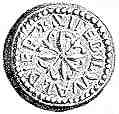
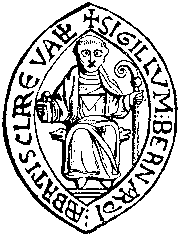
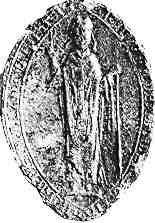
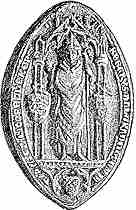
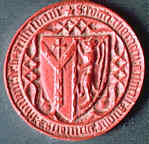
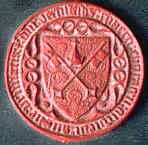
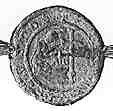
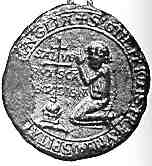
If you are looking at this page without frames, there is more information about medieval writing to be found by going to the home page (framed) or the site map (no frames).
| Seals of Clergy | |||||
| Individual members of the clergy had their own personal seals, as well as using those of the institution to which they belonged. | |||||
 |
This seal, known from a matrix in the British Museum, is one of the earliest English seals of a bishop known, dating from the 9th century. Its simple design, with an inscription around the edge of the circular seal, is very different to the more elaborate seals of senior clergy, such as bishops or abbots, of later times. | ||||
| Seal of Aethelwold, bishop of Dunwich. | |||||
 |
At left, seal of Abbot Bernard of Clairvaux. At right, seal of Archbishop Theobald from a charter of 1149 (Christ Church, Oxford). (From Salter 1929 |
 |
|||
| The official seal, or seal of dignity, of a high ranking clergyman was usually in the form of a large pointed oval. A common motif was a figure in ecclesiastical vestments and carrying the pastoral staff, in the act of benediction. The figure could be standing or seated. | |||||
 |
The style persisted throughout the middle ages, but as with other types of seals, became more elaborate during the course of the 13th and 14th centuries. Architectural canopies appeared and heraldic motifs were displayed. As with secular and institutional seals, the similarity with the monumental forms of funerary sculpture is notable, despite the fact that the delicate seal matrices were created by engravers or goldsmiths. | ||||
| Seal of Roger de Northburgh, bishop of Coventry, 1322-60. | |||||
| Other forms of the seal of dignity of senior clerics developed, including examples which showed patron saints or the Virgin and child. Heraldic designs were also used. | |||||
 |
The two sides of a late 14th century seal of Robert, Archbishop of York, from a facsimile. |  |
|||
| The example above resembles some secular seals, being round, with a shield set on a tracery background. The shield on the right bears the keys of St Peter, representing the dedication of the cathedral at York. The left side of the shield on the left indicates the status of the archbishop with a crucifix and pallium, the item of vestments which was worn specifically by an archbishop. | |||||
| Some orders developed their own particular style, notably the Knights Hospitaller or Order of St John of Jerusalem. | |||||
 |
Two seals from the same document; on the left that of Roger de Molins, Master of the Hospitallers; on the right that of Prior Garnier de Neapoli of the Hospitallers, on a chirograph of 1185 (British Library, Harleian Charter 43 I. 38). (From Warner and Ellis 1903) |
 |
|||
| Seals of members of this order tended to be round and to show a figure kneeling at a patriarchal cross. While the seal of the prior is a normal wax seal, that of the master is a leaden bulla attached by cords in the manner of papal seals. The designs are similar, although reversed, on each, but the example on the right is easier to make out. | |||||
|
|
|||||
|
|
|||||
|
If you are looking at this page without frames, there is more information about medieval writing to be found by going to the home page (framed) or the site map (no frames). |
|||||